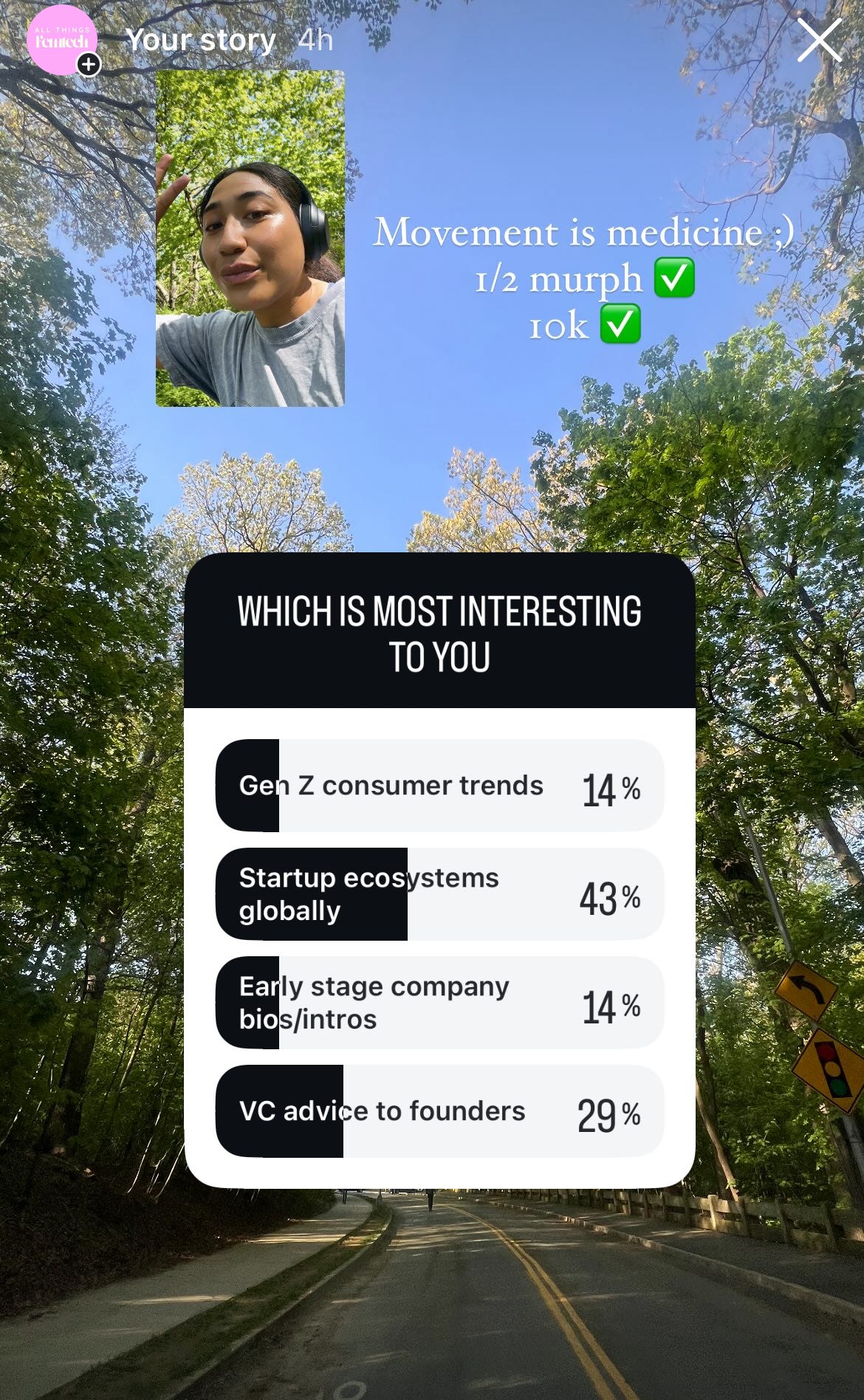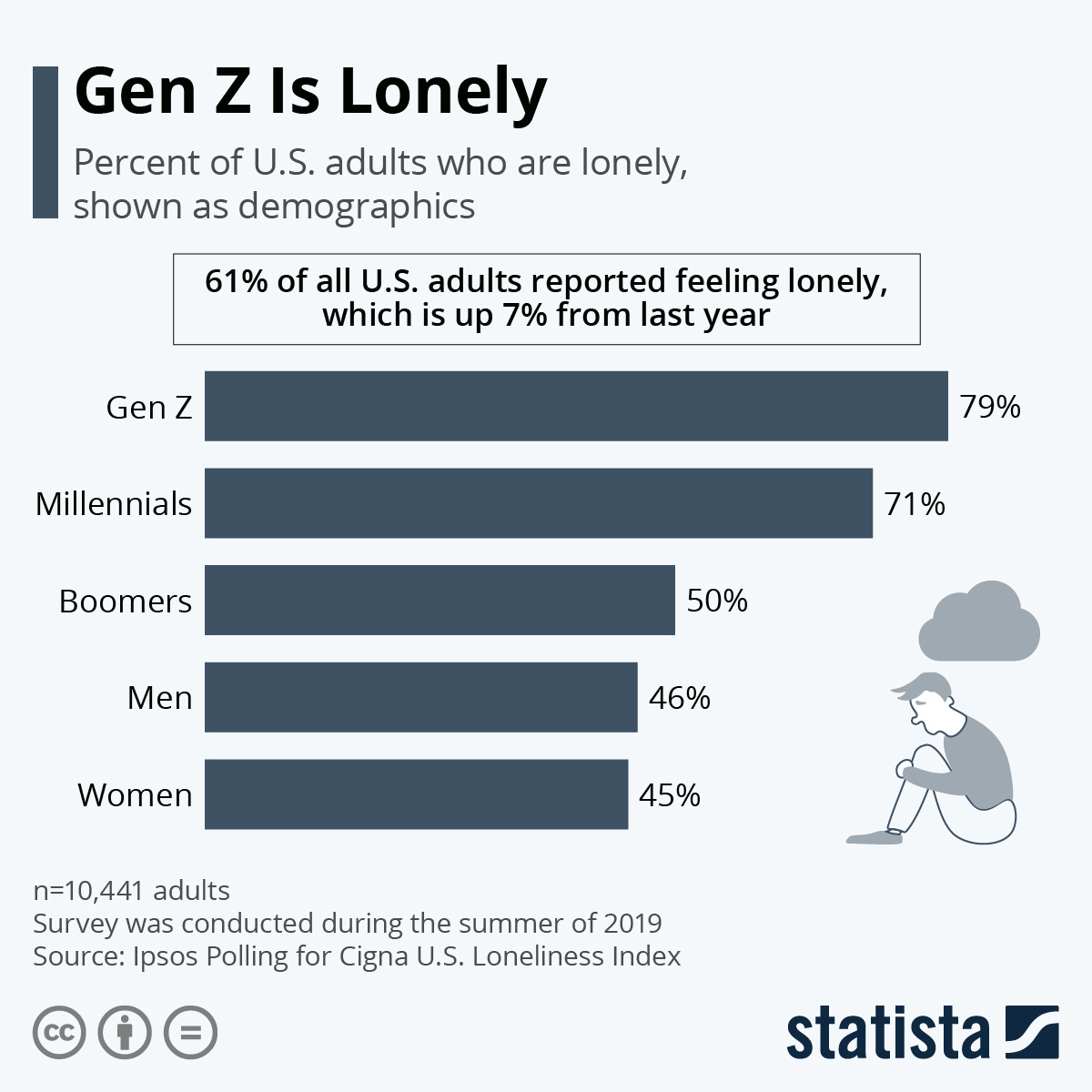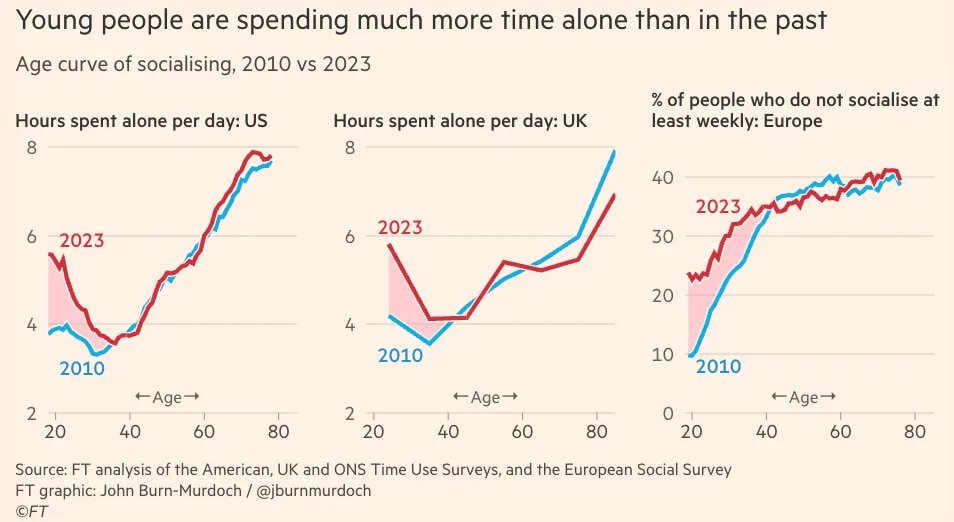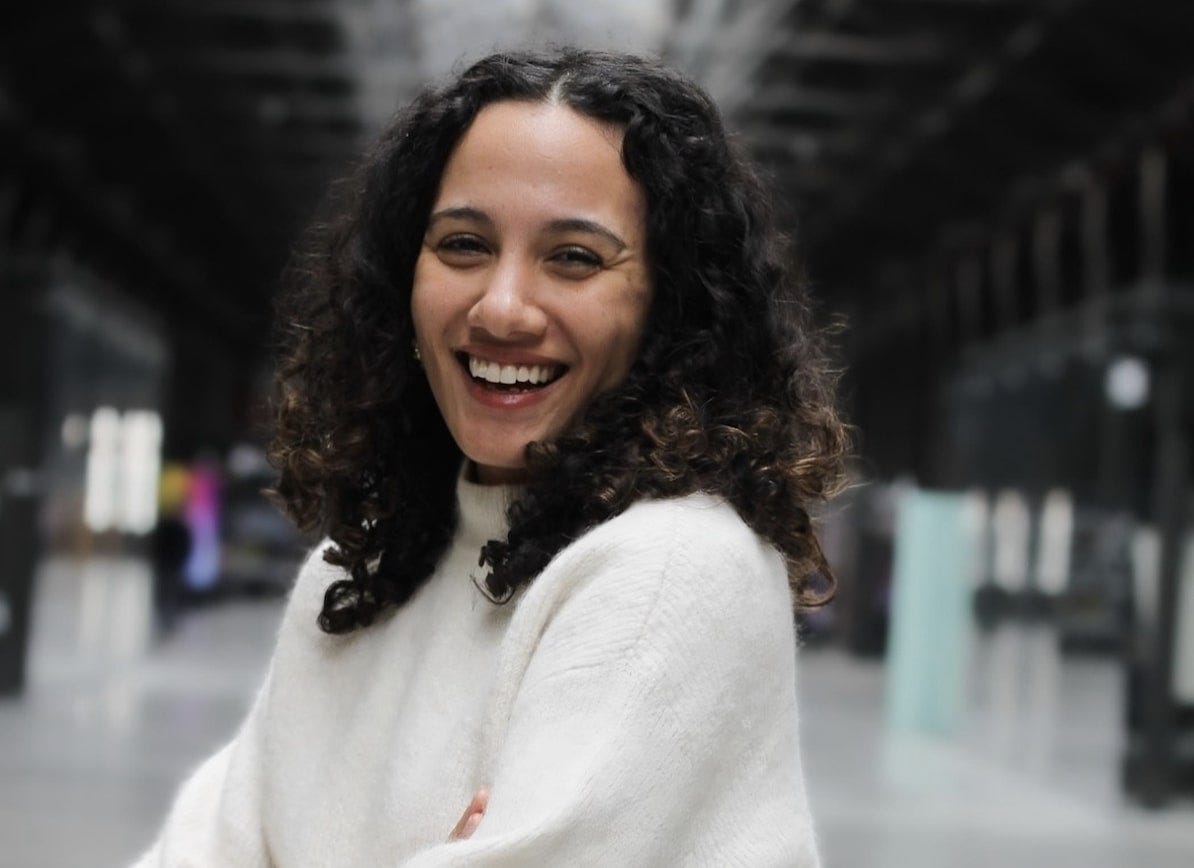Gen Z's ChatGPT Pocket Therapist. AI Ethical Concerns. All Things Femtech Summer Tour.
Because who needs therapy, ethics, or sunlight when you have Wi-Fi and a European summer? (sarcasm)
Founder Journey: European Summer
I ran a poll last week about what topics I should cover next. The people have spoken.
Startup ecosystems, globally. That was the winner. So naturally, I bought a one-way ticket to Germany.

I know, hilarious. But here we are.
In June, I’ll be wandering around Stuttgart, Munich, Berlin, Amsterdam (attending hlth. Europe- let me know if you will be there), soaking up the European sun and pretending it’s research (it is). If you’re a founder or researcher in the female health space, let’s meet up. I’m an in-person kind of girl. Zoom calls are fine, but herbal tea tastes better across from an actual human.
Honestly, I just figured it was time to put my newsletter to good use.
This little journey is part of growing All Things Femtech (ATF), a media and investment platform disguised as a newsletter. But let’s rewind.
Last year, I launched a femtech venture out of the Middle East. At first, I didn’t even know it was a startup. Then we started winning pitch competitions, pulling in non-dilutive grants, and fielding actual angel investment offers. I was building before I knew what building was.
Since then, I’ve seen how wide the gaps in women’s health actually are and how little most people are doing to fill them. ATF is my way of mapping the space, connecting the dots, and spotlighting those who are doing the work.
So yeah, founder mode has been reactivated.
Europe is just stop #1. Stay tuned for a chaotic, caffeinated (figuratively), femtech-powered summer.
I don’t prefer coffee, but always down to meet. Bring your story, and I’ll bring the herbal tea.
Gen Z Decode: Chat, are we cooked? (Guys, are we screwed?)
When I was in high school, every time something went sideways, like a bad grade, weird attitude, or mood swings- my mom (Happy Mother’s Day to the amazing moms out there) would say, “It’s that phone” (She really meant all technological devices in general). Like clockwork. I’d roll my eyes. Obviously, the phone wasn’t the reason I bombed chemistry. It was the teacher. Or the system. Or whatever excuse I cooked up that week.
But now I’m not so sure.
I was reading this newsletter about “friction” the other day. In this case, I will define it as the effort or kind of work it takes to move through the world. And how Gen Z (my people) doesn’t experience less of it. We just experience it differently.
Here’s the thesis: Friction or effort hasn’t disappeared. It’s just been outsourced.
The digital world is built to eliminate effort. You can auto-generate an essay. Skip office hours. Text your AI therapist or ChatGPT. Everything’s instant, optimized, and efficient. And in a winner-takes-all economy, what did we think was going to happen? Of course, people are cutting corners, outsourcing effort, and curating themselves into something palatable for the algorithm. Tech doesn’t lead culture rather responds to incentives. And when the incentive is dominance, you mostly get systems that scale. The whole system is designed to keep us online and logged in. We were told tech would free up our time. But it didn’t give us more time, it gave us more screen. And now loneliness? Loneliness is a market. AI friends are a product. Simulation is the new economy and the new friend.
We're living through an epidemic of loneliness (as many have discussed), but the solution being engineered isn't more human connection. It's simulated companionship that's both profitable and… frictionless.
-Kyla Scanlon, macroeconomist educator
Meanwhile, the physical world is...exhausting. Making friends takes work. Showing up takes effort. Dating? Forget about it. It’s easier to vibe with a chatbot or doom match on Hinge than risk actual rejection. So we stay in. We stay isolated. We stay...scrolling. But we’re still lonely. Because convenience doesn't equal connection.
Then there’s a third world. Let’s call it the curated. Where friction hasn’t disappeared, but has been repackaged as luxury. It’s not that effort is gone but that in certain spaces, you can pay to bypass it. Think wellness apps, fertility trackers, $200 supplements in beige packaging promising “empowerment.”
In these spaces, friction isn’t systemically resolved rather it’s glossed over with vibe, UX, and carefully worded affirmations. These products and platforms offer a sense of intimacy and agency, but often through performance rather than infrastructure. They say things like “own your cycle” and “take control of your health”, but often stop short of meaningfully improving access, outcomes, or systemic barriers.
This isn’t to say those tools are bad. In many cases, they do provide real value. The problem is when branding outpaces substance, when health becomes more about the feeling of being cared for than about actual care. It’s what some call health theater. Beautiful branding over opaque outcomes. Aesthetic care over clinical care. It looks like progress. It feels like control. But often, it’s still the same fragmented system underneath, just with better lighting.
And that’s by design. The wellness aesthetic is profitable. In a venture-funded world where success is measured by DTC conversions, TikTok virality, and community “vibes,” it’s faster to sell empowerment than to build systems that deliver it.
This new version of “effort” has also become a class marker. Just the reality of how friction functions in modern consumer health. But if we don’t name the dynamic, we can’t build against it.
Real care takes time. Loud and sometimes performative empowerment scales. That’s the tension.
AI Companions: Comfort or Concern?
Sentio University theorizes that ChatGPT may be the largest provider of mental health support, citing 96% of their surveyors using the LLM. One speculative survey suggested that 80% of Gen Z participants would consider marrying an AI, extreme, yes, but revealing of how blurred the lines between support and simulation are becoming. 55% of Americans aged 18 to 29 are comfortable discussing mental health concerns with AI chatbots or the pocket therapist ChatGPT. That doesn’t mean everyone’s in love with their bot, but it does signal a cultural shift in how emotional labor is being outsourced and how people are describing genuine emotional bonds with AI.
ChatGPT is a language model, not your therapist. Its job isn’t to tell you what’s good for you, it’s to give you something you’ll perceive as useful. Sometimes that overlaps. Sometimes, it doesn’t.
From a generation raised on digital ease, pocket therapy just makes sense. It’s always on, always available. Always ready to serve up advice, hold space for your spiral, whisper affirmations at 2 a.m., and never, ever judge you. Best of all? It’s free. Convenient. No office. No scheduling. No leaving bed.
But here’s the irony, all the friction we’re avoiding like the commute, the eye contact, the uncomfortable silence with a real human being, might actually be the medicine. The effort is the therapy. Because sometimes it isn’t so much about making things easier but about learning to carry the hard stuff together.
Studies from Harvard suggest that AI companions can help reduce loneliness if users feel heard and understood. But the risks? Real. Too much reliance, and real-life relationships atrophy. AI can supplement, but not replace, human connection. Eric Schmidt (former Google CEO) even warned that "perfect" AI partners could make loneliness worse.
Add social media to the mix, particularly platforms like Instagram and Snapchat and you’ve got a cocktail of isolation. Young women are especially affected, with research pointing to increased depression linked to social media exposure. Add gendered stressors like beauty standards and safety concerns, and the mental health gap deepens, particularly for those already marginalized. Because Gen Z women aren’t a monolith. Access to care, tech, and community is stratified by race, class, geography, and culture. The algorithm doesn’t flatten those realities but rather magnifies them.
Femtech’s Ethical Dilemma: Connection or Convenience?
And this is where femtech, especially digital-first brands, has a choice to make.
If you’re building mental health tools, cycle trackers, or AI-based wellness platforms targeting Gen Z women, you’re not just building tech. You’re shaping relationships. You’re entering sacred space. The intimacy economy. And the ethics aren’t optional.
So what does responsible look like?
IRL-first thinking: Apps shouldn’t just track feelings but should nudge users to engage in real-world community. Whether it’s peer-led meetups, group wellness experiences, or city-based connection hubs, digital tools need physical extensions.
Transparency over polish: Stop selling empowerment through aesthetics. Show evidence, outcomes, and impact not just branding.
Design for interdependence, not isolation: Create tools that deepen real relationships. That makes talking to humans less intimidating and not obsolete.
Femtech has the chance to be both innovative and intimate. But only if it remembers that healing isn’t frictionless. It’s relational. It’s messy. It’s human.
Building in women’s health or femtech?
Got news to share or want to sponsor All Things Femtech? Reply here or reach me at nilahmataafa@gmail.com. Let’s make it happen.
All Things Femtech is an entirely reader-supported publication that brings social sciences research into frequently overlooked topics. If you read it every week and value the labour that goes into it, consider liking or sharing this essay or becoming a paid subscriber! Or consider buying me a coffee instead!
Curation:
Pinterest becomes a key shopping platform for Gen Z consumers (Business Insider)
Menopause care gains attention with brands entering the market (Vogue Business)
Concerns raised over lack of female-only medical trials in the UK (The Guardian)
British Business Bank urged to support female founders more effectively (The Times)
Gen Z drives demand for multifunctional products amid economic uncertainty (Business Insider)
Mental health remains a top concern for Gen Z, influencing consumer behavior (Verywell Mind)
Deal sheet and Fundraising:
Magcath receives €535K to support European launch of incontinence device (Femtech Insider)
Valerie secures £514K to expand perimenopause wellness offerings (TheIndustry.beauty)
Viemed acquires Lehan’s Medical Equipment for $26M to expand into maternal health and respiratory care (GlobeNewswire)
The Cycle: Virginia the VC
I had the pleasure of sitting down with Virginia while she was in the thick of Techstars Torino, calm, sharp, and incredibly grounded despite everything on her plate. She's worked across aerospace, robotics, and early-stage venture, but what stood out to me most was how deeply she thinks about founders. We talked about what makes a pitch actually resonate, how technical teams can learn to tell better stories, and what she wishes more women in tech knew before asking for capital. Her background is layered: Dominican and Italian, trained in Australia, now back in Italy, building up a part of the ecosystem most people overlook. I learned a lot from this conversation and hope you do too.
Nilah:
I wanted to start with your global background in Italy, Australia, and now back in Europe. How has that shaped how you invest and support founders?
Virginia:
I’m Italian-Dominican. I left Italy during the financial crisis to study in Australia. Back then, it felt like a stable launchpad. I was set on investment banking, but realized I was more drawn to building.
I launched a small sustainable fashion startup. I didn’t even know it was a startup at the time. I did everything alone, with no investor support, and it fizzled. But that experience got me hooked on early-stage building.
Now back in Italy, I work with mostly international funds, often American ones. So I bring fast execution and direct feedback to founder ecosystems that are slower and more traditional, like in Southern Europe.
Nilah:
Totally. I’ve seen that too with my work in Lebanon. Cross-cultural context really shapes how you build.
From your side, what underrated traits do you look for in early-stage founders?
Virginia:
Three things:
Clarity on the problem. Either founders romanticize it or get too technical. I want clear, critical thinking about why this problem matters and why now.
Curiosity. Are they obsessed with understanding their users? That’s a sign they’ll build something people actually need.
Customer obsession. Not just solving a problem in theory, are they in conversation with real users and iterating accordingly?
Nilah:
Love that. I also think first-time founders often get caught in “impress mode” instead of being themselves.
What do the best founders do before fundraising?
Virginia:
They tailor the pitch. Founders who take time to research me like what I care about, what I’ve invested in will stand out.
I want to see early signs of product-market fit, yes, but also how they think. How did they get customers? How do they retain them? What’s their GTM logic?
Also, vision. Don’t only talk about traction. And don’t only talk vision with no execution. Balance both.
Nilah:
You’ve supported a lot of technical founders. How do you help them tell better investor stories?
Virginia:
I say this constantly: Keep it simple.
Founders, especially technical ones, get caught up in complexity and perfection. But storytelling is about clarity. We coach them to move fast, test, iterate, and stop waiting for “perfect” to pitch.
Nilah:
You’ve led women-focused programs like FoundHer. What advice do you have for overlooked femtech founders?
Virginia:
Ask for help early. Don’t wait until you’re overwhelmed.
Underrepresented founders, especially women, often hesitate to reach out unless things are perfect. Meanwhile, some male founders will fire off a pitch with typos and no shame.
Also, be critical. Not every “diversity” initiative is genuine. And don’t be afraid to dream bigger. I’ve seen founders with explosive growth who didn’t realize they could push further because they didn’t ask.
Nilah:
How should femtech founders explain stigmatized or niche problems to investors who might not relate?
Virginia:
Know your audience. If the investor is health-focused, skip explaining the problem and go straight to your solution.
If they’re not health-native, explain how your users engage with the product. What’s the behavior, what’s the transformation, what’s the vision? That’s what non-specialists want to understand.
Also, always check what’s already in their portfolio. It’ll guide how you frame the pitch.
For example, I’ve seen a lot of startups in the menstrual and endometriosis space. And in so many of those pitches, founders spend most of the time explaining what endometriosis is. But I already know that. What I want to hear is, how are you supporting your users? What’s the experience like for them? What kind of community or ecosystem are you building around the product? That’s the part I find most compelling.
Nilah:
What do you wish more founders knew after they get the check?
Virginia:
That we’re part of the team, not just someone to impress or hide problems from.
Some founders go quiet out of fear. Others won’t make a decision without us. Healthy founder-investor relationships sit in the middle: trust, transparency, and independence.
Also, founders should remember: VCs are selling themselves too. You’re choosing us just as much as we’re choosing you.
Nilah:
What’s one thing early-stage founders should prioritize right now?
Virginia:
Product-market fit. Talk to users constantly.
Build the right team, not just the available one.
And don’t default to VC. Make sure you have a strategy and some logical financial assumptions, even if they’re rough.
Start organizing early, even if you’re just two people. Future you will be grateful.
Nilah:
Last one: any founder or trend you’re excited about right now?
Virginia:
I’m excited about robotics, especially where physical and software systems meet. Surgical robotics, assistive tech, that kind of thing.
In femtech, I want to see innovation beyond fertility. I think we need tools that empower people to take action, not just track symptoms. And I’d love to see more founders rethink healthcare, not just from a “women’s” lens, but from real user experiences across demographics.











As someone who wants to start something innovative for women’s healthcare, this newsletter is giving me really good insight on what that truly means. Thanks !